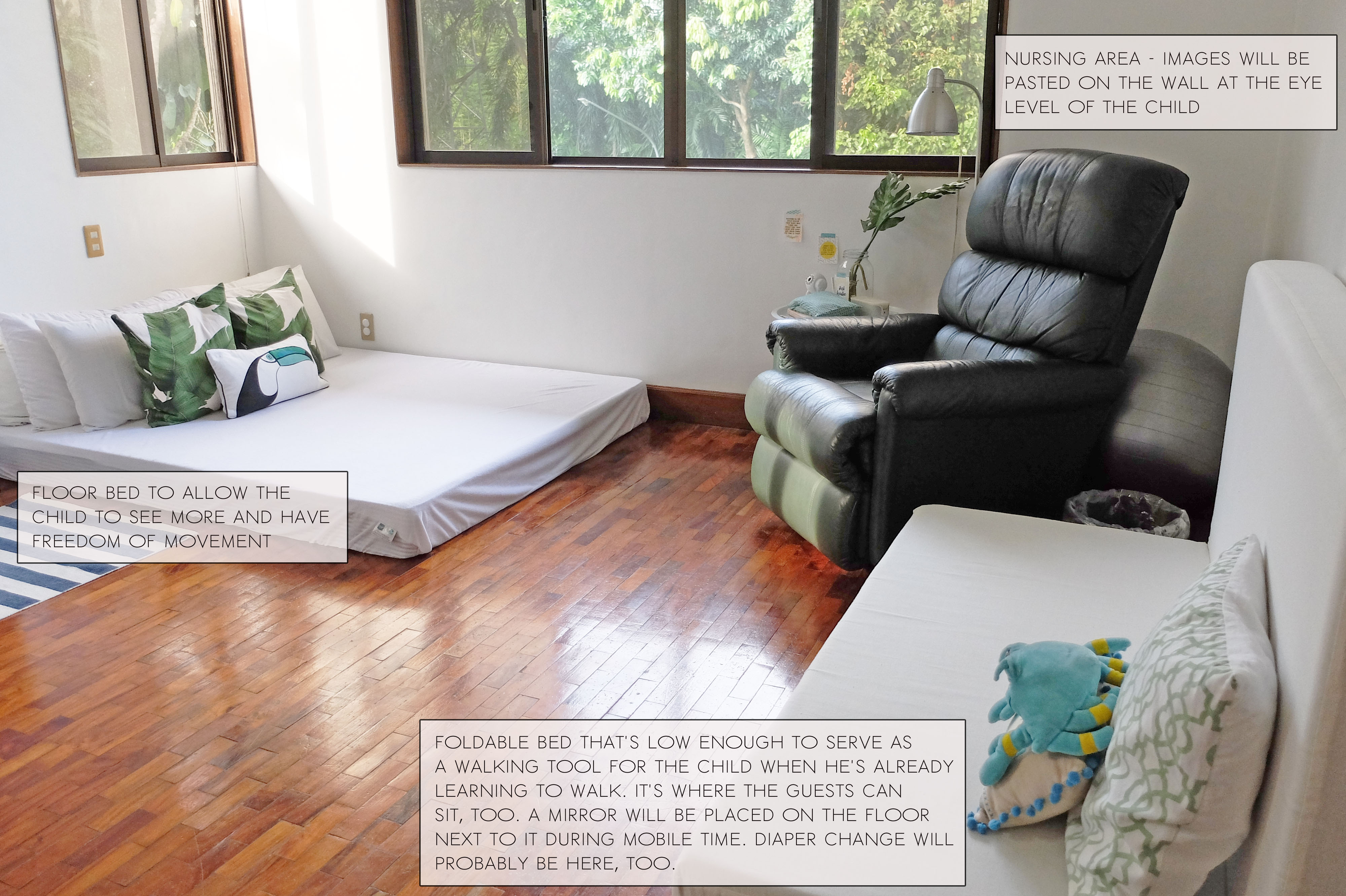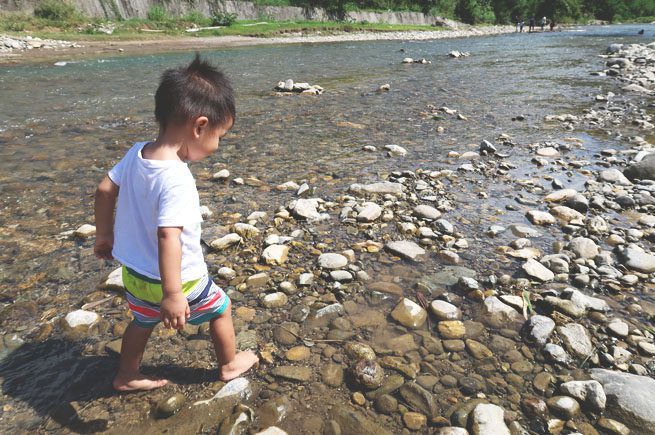If you read the principle of Montessori on infants, there really is much stress in freedom of movement. Infants can slither from birth, and continue to develop their body throughout the year. In the second month of life, the muscles of the neck are brought under control and the head can be supported without assistance. Between the third and fourth month, coordination begins to extend to the hands. At the age of five months, they are already slithering skillfully. By the sixth month or seventh month, the child is able to sit. By the eighth month, the child has perfected the technique of crawling, so by the ninth month, he can stand and pull himself erect with the help of nearby support. Somewhere between the eleventh to twelfth month, the child begins to walk.
Our role as parents is to assist in voluntary movement from birth, yet, as Dr. Silvana Montanaro wrote in the book Understanding the Human Being, “a tragic aspect of the development of movement is that generally, the more children are able to do, the more they are restricted in their freedom of activity. They go from crib to infant-seat, baby carriage, high-chair, and playpen.” Now that I think about it, it really is quite ironic that after months of a child perfecting the art of crawling and/or walking, we celebrate this conquest by restraining him in small, confined spaces such as playpens and cribs!
Freedom of movement is very important for children because unlike adults who just mostly use sight for everything, children learn through their five senses. Hence, creating a space where they can explore safely and freely leads to enhanced learning and understanding.
I admit, when I first made my son’s room, I was hesitant to follow the Montessori-recommended room (to have an idea, go HERE). I felt like my practicality was more important (fixing a room that would look the same for the years to come) and of course, I wanted to maintain a certain theme that’s pretty to my eyes.
Before I show you how it looks now, here’s a peek of what it looked like back when it was still a guest room (Filipiniana theme) and when I first learned I was pregnant (camping + birdwatching with green and blue as heavy colors since I learned that green is one of the best colors for learning, and blue maintains a calm environment).
And then I kept reading Montessori books (you can find my pregnancy reading list HERE and scroll down to see the Montessori list), and finally, I was convinced that a Montessori-inspired room is best for my child. I realized I had to change the room and design it not for me but for my child.
Here’s how it looks now:
And here are pointers of what I did and why:
Montessori-inspired rooms would have the following features:
- Child Bed/ Floor Bed (Yes, no crib!) – with a low bed, the child gets a visual map of the bedroom even before he starts to move around. A crib obstructs a child’s vision and restricts movement. Moreover, a child cannot explore on his own and has to wait for an adult to pick him up from the crib before he can move around. This establishes unnecessary dependence on adults. One of the things Maria Montessori taught is that a child’s cry means “Help me do it myself!”, and a low/floor bed can help him do important things by himself.
- Baby-proofed space: You want your child to have the freedom to explore, but it is also your responsibility to ensure the safety of his environment for exploring. Check out furniture edges that might be too sharp, cover the electrical outlets, place lamps out of reach, keep floors clean and free of items small enough to swallow, put mats in areas that will be used for exploration, etc.
- Montessori Mobiles – There are specific mobiles designed for the Montessori method of learning (will blog about our DIY experience next time). They were made to accommodate the child’s habituation and match his progressive visual development. They were designed to develop focus on moving objects and learn about perception and depth. What sets them apart is that the mobiles must be given when the child is awake and not meant to make them sleep. We did not buy a single commercial mobile (I ordered a set of crochet balls from a crafter, though. I just cannot succeed in anything crochet!). The plus point is that we saved a lot by doing the mobiles by ourselves, but even better is that I know that the mobiles we made are useful and purposeful for our baby’s development. We put hooks from one end of the room to the other where we can hang a rope when the mobiles need to be hung. We also made a portable wooden mobile hanger that we can bring outside.
- Child-sized furniture – I was hesitant about this at first, because that would mean changing the furniture again after some time. But really, this is the best decision we’ve made for the room. One of the best interior advice I’ve read for setting up a nursery is to sit down and look around the room. Whatever you see at that level is what your child will most likely see. There really is no use putting up pretty photos and baskets at adult level when the child cannot even see it. Think about it: would you have interest going around a museum where the paintings are so high that you’d have to look up all the time? Would that kind of environment be inviting for exploration? Having adult-sized furniture will make the child feel that he’s too small and the world is too big. In that situation, the child will always need your help to get things when a low-lying shelf will solve that situation for you and help a child form independence and responsibility. The plus side is that these will also serve as training tools for your child for walking. No need for walkers of any sort. PS: I had his shelf made. My husband and I designed it and the upper part is detachable should it still be too high for our son. Other furniture found in the room that are child-sized: a bench (that can serve as a table someday) and a foldable double-sized bed. I had off-white canvas covers made for them.
- Low, open shelves – For the child’s exploration. The idea is to put mindful things that would interest him there – but not too much that he will be overwhelmed. It is the perfect place to practice and establish simplicity, beauty, and order, too (these are three concepts of Montessori). Thankfully, I love wooden and natural baskets, trays, stands, etc, so I did not have to buy anything for the shelf except for the wooden bunny from Bannor Toys. The books were carefully selected, too. We already have a lot of books for him, but they are kept somewhere else for the time being. The transparent acrylic stand (where the Zebra image currently is) is also perfect for displaying printed graphics such as high-contrast images, paintings, or photos!
- Mirror – You may attach it to the wall next to the bed, or you can put it beside your intended area for the nursery mobiles. A mirror enhances sight by showing a different view of the room. The child also sees his own image and sees the connection of his movements. Our mirror is kept in our bedroom and will only be put here whenever needed.
- Low paintings/ photos – High contrast images, beautiful paintings, and realistic photos may be pasted on the wall (I would go with washi tapes so there are no marks on the wall after use) at a level the child can see. It’s never too early to introduce beauty and reality to children. Realistic images are preferred over the cartoon type of images because children are just learning about the real world, and giving them unrealistic images may have harmful effects later on (children don’t get a clear understanding of the real life’s consequences when they’re exposed to unrealistic images). Their experiences with the real world become the basis for imagination and creative thought in their elementary years, that is why it’s important for us to show them things that represent truth. Fantasy can come later on (ages 6 up) when they already have a reasoning, and not an absorbent mind. Luckily, for this room, we really had existing low light switches, too. This would be useful when the child is bigger and can already turn on and turn off the light by himself.
- Nursing Area – a nursing chair with nearby photos for the child to look at when he’s on the chair.
- Baby Monitor – well, this is just a plus for us since I got a hand-me-down from my sister. When we know the baby is safe in his room, we can manage to be several minutes out of his sight (but him not from ours haha)! We can talk to the baby from the other room to reassure our presence. If we do this gradually, the baby learns to to manage without us for brief periods. The book Montessori from the Start writes (p.78), “We lay a foundation for an understanding, so important in a healthy adjustment to life, that physical presence is not essential to trust and a feeling of oneness with loved ones. Many parents neglect to consider this key concept until their babies are older, perhaps fourteen months or more. By this time, the child becomes accustomed to one or the other parent’s constant presence and attention whenever he’s awake. Such dependence becomes trying when the baby is older and is ready for more interaction with the environment.”
So there. This is how I did our Montessori bedroom. I cannot wait to see it in action. It was not easy doing this (it required a lot of thinking and planning), but now, I’m really glad I did. Let me know your thoughts and tips! Have fun decorating your nursery!
PS: The nursery room is actually a different room from the guest room and the first nursery. They’re quite identical, and when my sister sleptover at the first nursery for two weeks, she told me my son’s nursery that the noise might be disturbing for an infant since that room was by the roadside. So we moved everything to the other room that’s quieter.










5 Comments
Did you also make the floor mobiles? Looking forward to your DIY, hope you can share where you buy your materials too. My son is turning five months now and unlike you, I only read about montessori infant mobiles. I know I’m late but it still worth a try. Love the room of Pablo!
Best wishes to you and your son <3
Love
~A
http://www.aizhaguevarra.blogspot.com
Thank you! Will share our DIY next time (by floor mobile, do you mean the wooden mobile hanger? My husband made it.) For now, you can look up Montessori Mobiles online and you’ll see blogs about it. Goodluck in your Montessori journey!
hi paula, i have been a fan of yours since ang tv days. i would like to ask where did you bought your mini globe?
best wishes
I forgot already; got it in Singapore. I think TYPO or one of those types of stores. 🙂 Thanks for dropping by!
Hi! I have a 3 month old baby boy, , and I’m wondering how you plan to go about teaching your baby the self soothing part? I’ve been struggling with this and I want to keep a balance. . Thanks in advance for your response!